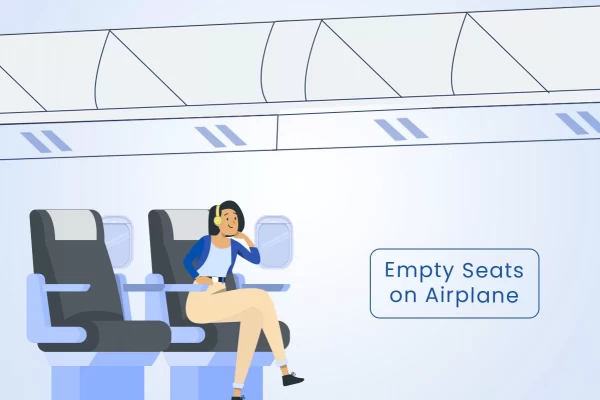Why are Seats on an Airplane Left Empty

When traveling by flight, you often see empty seats on a plane. Passengers might wonder why these seats are left empty on the craft. Afterall, airlines usually declare no seats available even though a passenger might have to fly urgently. It might seem as though the seats were left empty because some passengers were a no-show or less people were booking seats. But some seats are kept vacant on an airplane for load management.
1. Length of the Runway
A plane can get a load penalty due to the increasing temperature, geographical difficulties of the airport or the length of the runway. Seats are often left empty on a plane to manage this. While some passengers may suspect that the seats are left empty in order to increase the price of the ticket, this is not the case. To explain simply, the load penalty is calculated mainly based on the length of the runway, airport schedule, air pressure and wind speed. On most flights to Pokhara, some seats on the plane can be seen kept empty. But why is this even when the weather is clear and the runway is capable of landing large ships?
2. Load Management for Safety
The issue of load management is closely related to aviation safety. For airlines, safety is the first priority and their business runs on safe flights. Before each flight, the passengers traveling on the flight and their cargo are arranged. In this case, the load that can be carried on a certain flight to a certain airport is determined and checked by the airline staff. After taking approval from the regulatory body, some seats are kept vacant for the management of the ship’s load. Before the seats are filled with passengers, the airline staff make extensive preparations for load management. Arrangements for taking off and landing are made by adjusting the weight ratio of passengers to luggage.
3. Temperature of the Airport
“There are several technical reasons to reserve seats on a board. One of them is that the take-off and landing depends on the temperature of the airport.” says Jaganath Niraula, spokesperson of the Civil Aviation Authority of Nepal. “During take-off and landing at an airport with high temperatures, the load is reduced as the performance of the aircraft decreases.” This issue is more common in the summer season. Due to increasing temperature, there is a difference in air pressure. If the luggage carried by passengers is heavier than the allowed weight, some passengers in the aircraft have to be vacated. Also, due to weather and technical reasons, the aircraft might have to land somewhere else before reaching the destination airport. In order to avoid this, adequate fuel needs to be kept in the ship which also increases the load of the plane.
4. Geographical Difficulties
Another important reason for keeping seats vacant is geography. Airports with geographical difficulties such as Kathmandu and Tumlingtar need to be paid more attention, as when the temperature increases, the ability of the aircraft to cross the obstacles decreases. Therefore, some seats are kept empty for safe flight and landing after crossing those geographical obstacles. The only way to manage the ship’s load is by not keeping some seats for sale. This way, the load can be managed. Passengers and baggage are managed in order for essential fuel to be filed. Due to the lack of air fuel system in some destinations, planes have to fly with more reserve fuel oil while taking off from the destination it is flying to. Therefore, passengers, luggage and cargo have to be reduced.
5. Technical Reasons
In case of Nepal, the authority says that the ship needs to allocate more empty seats during the summer season. According to them, the airlines themselves have to work on the plane’s load management. In airports with short runways, the load capacity of the aircraft becomes low. It becomes even lower when the temperature increases, accordingly, the number of passengers and baggage on board is reduced. Buddha Air, a private airlines company which serves the largest number of passengers in domestic flights flying to numerous destinations stated that, “Due to technical reasons, even though the plane has two engines, it has to operate in the capacity of just one engine. If a problem comes in one engine while carrying passengers with one engine load capacity, a safe landing can still be made with the other engine. Hence, the passengers can have a safe journey."
How Budda Air Manages the Weight on an Aircraft?
From load management to training, Buddha Air has retained skilled manpower to work with the promise that there will be no reduction in the safety of passengers, Buddha Air claims. Buddha Air designed a “BHA Load and Trim Seat” software with the help of highly skilled and experienced flight engineers. This is how Buddha Air calculates and manages the weight on an aircraft for take-off and landing. In simple words, how much load a plane can carry on a flight from an airport depends on the length of the runway, temperature of the airport, altitude from sea level, air pressure and wind speed.
Taking off from a short runway reduces the load capacity of the aircraft, while taking off from a long runway increases the load capacity of the aircraft. Similarly, high crosswind speed during takeoff reduces the load capacity of the aircraft. The higher the airport is above the sea level, the lesser the load capacity of the ship will be. As the temperature increases, the load capacity of the ship will be reduced, so the passengers and goods on the ship will have to be reduced accordingly. So these are the reasons for empty seats on the ship. Next time you see empty seats on a flight, you know the reasons why.
